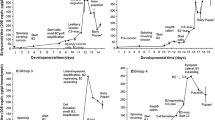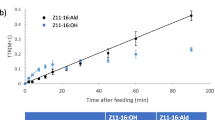Abstract
To determine the precursors and the fate of 26-hydroxyecdysone in eggs, the fate of labeled putative ecdysteroid precursors was examined in the tobacco hornworm,Manduca sexta. Following injection of [14C]cholesterol, 22,25[14C]dideoxyecdysome or [3H]ecdysone into female pupae (day 16), only [14C]cholesterol was incorporated and metabolized. It was converted to labeled nonecdysteroid and ecdysteroid conjugates, of which the latter in ovaries and 48- to 64-hr-old eggs is mainly 26-hydroxyecdysone 26-phosphate (>85% in ovaries). Quantitation of the ecdysteroid conjugate by reversed-phase high performance liquid chromatography (RP-HPLC) showed that the levels of 26-hydroxyecdysone 26-phosphate were 31 μg/g of ovaries from 4-day-old females and 25 μg/g and 17 μg/g of 48- to 64-hr-old and 72- to 88-hr-old eggs, respectively. The RP-HPLC of the conjugate fraction of 48- to 64-hr-old eggs showed an additional peak of radioactive material eluting about three min before the 26-hydroxyecdysone 26-phosphate. The quantity of this material increased in the 72-to 88-hr-old eggs, though it was not detected in the analyses of the conjugate fraction from ovaries. Additional peaks of radioactive material eluting before the 26-hydroxyecdysone 26-phosphate peak were observed in the chromatogram of the conjugates of 72- to 88-hr-old eggs. These radioactive materials need to be identified to determine the ultimate fate of ecdysteroids in the developing embryos of the tobacco hornworm. No radioactive free ecdysteroids were detected in either egg age group.
Similar content being viewed by others
Abbreviations
- Ecdysone:
-
2β, 3β, 14α,22R,25-pentahydroxy-5β-cholest-7-en-6-one
- 20-hydroxyecdysone:
-
2β,3β,14α,20R,22R,25-hexahydroxy-5β-cholest-7-en-6-one
- 26-hydroxyecdysone:
-
2β,3β,14α,22R,25,26-hexahydroxy-5β-cholest-7-en-6-one
- 20,26-dihydroxyecdysone:
-
2β,3β,14α,20R,22R,25,26-heptahydroxy-5β-cholest-7-en-6-one
- 3-epi-20,26-dihydroxyecdysone:
-
2β,3α,14α,20R,22R,25,26-heptahydroxy-5β-cholest-7-en-6-one
- 3-epi-26-hydroxyecdysone:
-
2β,3α,14α,22R,25,26-hdexahydroxy-5β-cholest-7-en-6-one
- 22,25-dideoxyecdysone:
-
2β,3β,14α-trihydroxy-5β-cholest-7-en-6-one, and 26-hydroxyecdysone
- 26-phosphate:
-
2β,3β,14α,22R,25,26-hexahydroxy-5β-cholest-7-en-6-one 26-phosphate
References
Hsiao, T.H., and Hsiao, C. (1979)J. Insect Physiol. 25, 45–52.
Dinan, L.N., and Rees, H.H. (1981)J. Insect Physiol. 27, 51.
Lagueux, M., Sall, C., and Hoffmann, J.A. (1981) Amer. Zool.21, 715–726.
Thompson, M.J., Svoboda, J.A., and Weirich, G.F. (1984)Steroids 43, 333–342.
Thompson, M.J., Weirich, G.F., Rees, H.H., Svoboda, J.A., Feldlaufer, M.F., and Wilzer, K.R., (1985)Arch. Insect Biochem. Physiol. 2, 227–236.
Kaplanis, J.N., Robbins, W.E., Thompson, M.J., and Dutky, S.R. (1973)Science 180, 307–308.
Kaplanis, J.N., Thompson, M.J., Dutky, S.R., and Robbins W.E. (1980)Steroids 36, 321–336.
Thompson, M.J., Robbins, W.E., Kaplanis, J.N., Cohen, C.F., and Lancaster, S.M. (1970)Steroids 16, 85–104.
Kaplanis, J.N., Thompson, M.J., Yamamoto, R.T., Robbins, W.E., and Louloudes, S.J. (1966)Steroids 8, 605–623.
Telfer, W.H., and Anderson, L.M. (1968)Develop. Biol. 17, 512–535.
Kaplanis, J.N., Robbins, W.E., and Thompson, M.J. (1969)Science 166, 1540–1541.
Weirich, G.F. (1985) inMethods in Enzymology (Law, J.H., and Rilling, H.C., eds.) pp. 454–458, Academic Press, New York.
Thompson, M.J., Weirich, G.F. and Svoboda, J.A., (1985) inMethods in Enzymology (Law, J.H., and Rilling, H.C., es.) pp. 437–442, Academic Press, New York.
Thompson, M.J., Kaplanis, J.N., Robbins, W.E., and Yamamoto, R.T. (1967)Chem. Commun., 650–653.
Sall, C., Tsoupras, G., Kappler, C., Lagueux, M., Zachary, D., Luu, B., and Hoffmann, J.A. (1983)J. Insect Physiol. 29, 491–507.
Isaac, R.E., Sweeney, F.P., and Rees, H.H. (1983)Biochem. Soc. Trans. 11, 379–380.
Author information
Authors and Affiliations
About this article
Cite this article
Thompson, M.J., Svoboda, J.A., Feldlaufer, M.F. et al. The fate of radiolabeled steroids in ovaries and eggs of the tobacco hornworm,Manduca sexta . Lipids 21, 76–81 (1986). https://doi.org/10.1007/BF02534306
Received:
Issue Date:
DOI: https://doi.org/10.1007/BF02534306




